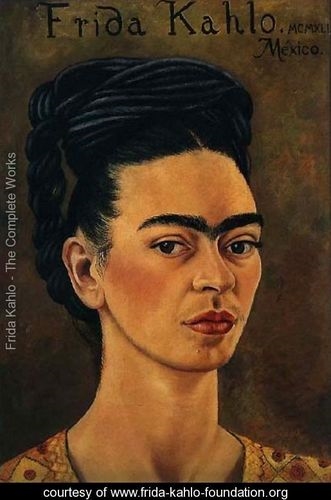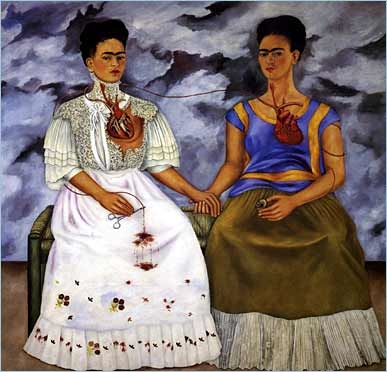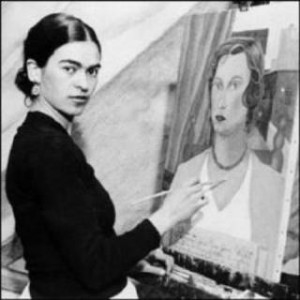 |
| Self Portrait of Frida Kahlo (http://www.frida-kahlo-foundation.org/Self-Portrait-1941.html (Frida Kahlo)) |
"I don't paint dreams or nightmares, I
paint my own reality" (Frida Kahlo). Frida Kahlo lived a life of anguish
and sorrow, in which she used as fuel for her paintings. She was born on July
6, 1907, in Coyoacan, Mexico. At age seven, she was diagnosed with polio, a
disease that stunted the growth of her right leg, and later in life led to
amputation. However, that was not the end of her suffering. In 1925, Kahlo was
involved in a bus accident. After the bus collided with another vehicle, an
iron bar mutilated her, stabbing through her pelvis and into her back. This
accident had permanently scarred her, leaving her with a lifetime of agonizing
pain. In comparison to the physical pain she felt, she considered her marriage
with Diego Rivera to be the worst. Rivera was a famous Mexican painter, and
also served as an inspiration to Frida, yet their marriage proved to be a
mistake. But through the great grief that she experienced, she shined light on
a new opportunity and brought forth a newfound talent of hers - painting.
Painting was her sanctuary, and became a channel for her explosive emotions.
She had turned pain into art, and used it in a way no other human being would
even consider to think. Her art is the symbol of her perseverance and ability
to create things from the deepest parts of the mind and soul. Others gaze at
her art with great admiration, considering the pain within them and the origin
of its deep background. Frida Kahlo overcame the suffering she faced,
portraying her determination, vast individuality, and passion for her work; she
used this to follow her dreams, inspiring others and becoming a cultural
revolutionist.
Frida pursued her dreams with determination, despite the challenges that held her back. She remained unfazed by the shadow her husband had cast upon her, and began to push forward and shine a light of personal accomplishment: "As Hayden Herrera noted in Frida Kahlo: The Paintings, Kahlo became a symbol of perseverance and strength for women. Unintimidated by the fame and ferocious artistic drive of her husband, she charted her own artistic course and created work of enduring power and significance. In 1984 the Mexican government recognized Kahlo's work as important to the country's national heritage" ("Frida Kahlo"). She kept a clear mindset to have the courage to continue to do what she loved and built her own path in the journey to success. Also, her strength and perseverance is what kept her going, and her artwork is expressed that. Her paintings were adored, and her perseverance inspired others to keep strong and do what they believed. She followed her beliefs with confidence, and remained herself all the way through: "She never betrayed her artistic vision, despite living in a conservative, Eurocentric, male-dominated culture, and she never shrank from depicting her experience as a woman, a Mexican, and a rebel" ("Frida Kahlo"). Kahlo was not held back by her culture, regardless of how it tried to block her. She, being a feminist, did not look down on herself and thoughts of betraying her culture never clouded her mind. She painted knowing that what she did was true and right to her, and was able to show all of her true colors. Even while facing the traditions of her culture, she overcame the obstacles and stayed strong throughout her entire career.
 |
| The Two Fridas (http://www.pbs.org/weta/fridakahlo/worksofart/index.html (Frida Kahlo)) |
Setting her apart from other artists, her paintings displayed an individual style. They contained many symbols and representations from her life, and were difficult to understand. For example, one of Kahlo's famous paintings, "The Two Fridas" (1939) shows her great emotion after a divorce with Rivera. In this painting, there are two Fridas pictured, each displaying a different feeling. One of the Fridas represents her love for Diego, and holds a small portrait of him in her hands. She wears a traditional Tehuana dress, and her heart-visible through her chest-is whole and unbroken. However, the other Frida represents the pain she suffered. She holds a pair of surgical pincers, dirty with blood that drips onto her dress. The blood shows the agony she faced with miscarriages, surgeries from polio, and her loss of Diego. This Frida's heart is severed and torn, exposing her feelings of rejection. The two Fridas are attached by a single vein, symbolizing that she is only connected to herself, because knows herself better than anyone else. The overall colors of the painting give a gloomy impression, and leave the viewer with a taste of the melancholy she was going through. And although her paintings were not always understood, she painted reality in the way that she saw it, and that was what made her different. This unique style of painting showed the brutality of reality, bringing forth her inner soul and creativity: "Her work largely addressed her pain-both the physical agony caused by her medical problems and the anguish of her relationship with Rivera, as well as her inability to have children. Many of the almost two hundred paintings she produced are self-portraits, often bloody and disturbing...Yet many of her self-portraits are also beautiful, revealing her inner strength, courage, and intelligence. All of Kahlo's paintings are rife with symbols-objects representing events in her life, religion, or Mexican culture and history" ("Frida Kahlo"). Each of her paintings showed a different part of her, and a different view of reality. She carved her feelings and thoughts into the art, and in turn was given a painting that was like no other. Her art was like a puzzle, and all pieced together to form what Kahlo truly was in a perfect and precise way. Keeping to her personality is also what makes her art so distinct, by putting original ideas out there when everything was often similar. When Kahlo painted, she poured her heart into all she did. With all the agonizing pain she experienced, it was all beautifully displayed on a canvas with intricate details and symbols.
She put all of her passion and love into her work and illustrates the beauty of reality, no matter how dark the background of the painting was. Her upmost deepest feelings were dug out and splattered onto a canvas, giving her paintings a further more personal effect: "'Frida's many self-portraits pierce into the deepest layers of her being and express what she found there in a manner so direct and so physical that their message seems universal,' Herrera, author of the Kahlo biography, remarked in the New York Times" ("Frida Kahlo"). Kahlo had a great dedication to her painting, and devoted herself into giving up her feelings in order for them to be shown to the world. The paintings had a deep effect to the people, which directly affected their souls by giving a beautiful message. With each detail she drew, Kahlo's adoration of painting became even stronger, continuing to flow with ideas: "It was around this time that Kahlo began to paint, beginning with portraits of her family and herself. From the start, her paintings-with their clear outlines, vibrant colors, and precise details-showed intense emotion and boldness. Kahlo took her paintings to Rivera, who felt she had talent and encouraged her" (Frida Kahlo"). Using this, she was able to push forward and put her thoughts out there, revealing the talent that would soon lead her into the real world. The sorrowful events that occurred, served as the spark, giving in to new opportunity. She had an immense load of emotion on her shoulders that could only be lifted by the one thing that completed her life: painting. She treasured her work and kept to her heart, bringing her reality into the paintings, and illustrating the beauty of life.
 |
| Frida (http://www.biography.com/people/frida-kahlo-9359496/photos (Biography.com)) |
Kahlo's vision of life showed through in her paintings, depicting the cruelty of pain and suffrage and illustrating it in an exquisite way. Frida enjoyed painting, and loved the results she received. She didn't care about what others thought, and that gave her a sense of differentiation and put her aside from others. She continued to do what she loved, despite the obstacles put on her, and held her head high in pursuing her dreams."The singer Madonna, a Kahlo fan, had this to say in Herrera's article: 'Frida Kahlo used her accident, her crippledness and her pain to her advantage in her work. She had a lot of odds stacked against her---the Latin American culture in which men ruled and they still do. She played the role of the submissive female, but at the same time she was in control'" ("Frida Kahlo"). No matter what held Frida back, she turned it around and used it for her own gain, for example: her pain. Her pain became the vision for her paintings, showing each detail in a prim way. Even after facing many hardships, both physically and mentally, she had the strength to remain on top. Frida continued to paint until the end of her life in 1954, turning reality into art, and dreams into success.
Works Cited
"Frida Kahlo." Dictionary of Hispanic Biography. Gale, 1996. Gale Biography In Context. Web. 21 Mar. 2012.
"Frida Kahlo." Newsmakers. Detroit: Gale, 1991. Gale Student Resources In Context. Web. 22 Mar 2012.
"Frida Kahlo." U*X*L Biographies. Detroit: U*X*L, 2003. Gale Student Resources In Context. Web. 26 Mar. 2012.
Hillstrom, Laurie Collier. Frida Kahlo Mexican Portrait Artist. Farmington Hills: Gale Cengage Learning, 2008.
Pawlik-Kienlen, Laurie.
"Inspiration from Frida Kahlo." Suite101.com.
Suite 101, 1 Feb. 2008. Web. 27 Mar. 2012.
Zempel, Jerilea. "Kahlo, Frida (1907-1954)." Encyclopedia of World Biography. Ed. Suzanne M. Bourgoin. 2nd ed. Detroit: Gale Research,1998. 17 vols.Student Resource Center - Junior. Gale. DEL NORTE HIGH SCHOOL. 22 Mar. 2012.
Page created on 4/18/2012 12:00:00 AM
Last edited 4/18/2012 12:00:00 AM
